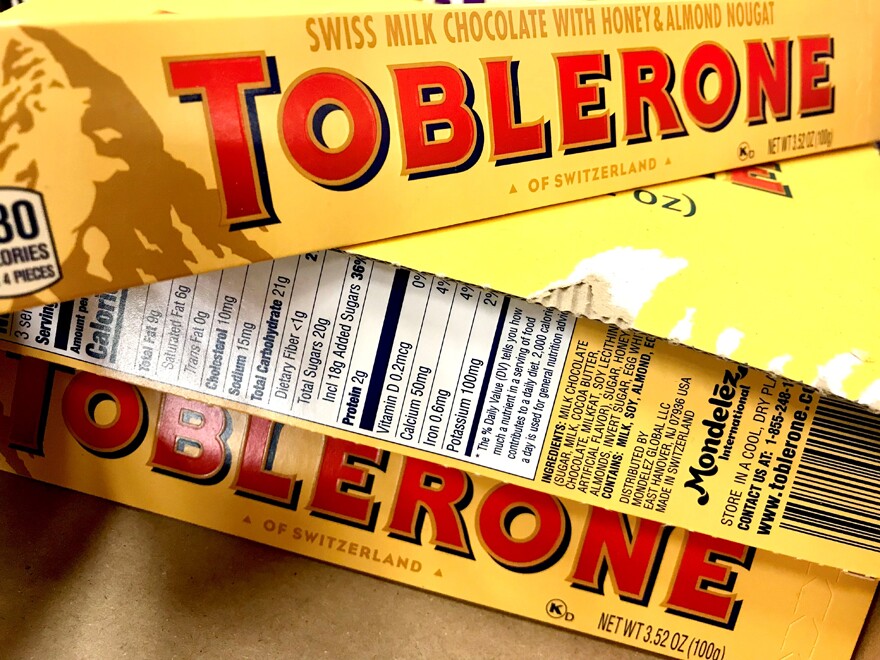I’m sure you’ve heard the distressing news by now. The Swiss legislature determined that Toblerone, the distinctive triangular chocolate bar, is no longer sufficiently Swiss to label itself so; or to employ Swiss symbols such as the image of the Matterhorn. The mountain appears on the package and the chocolate bar’s distinctive shape mimics it. In the future Switzerland’s most famous peak will be replaced by a generic mountain.
Until I read about the kerfuffle I was frankly unaware that an image of a bear is concealed in the shadows of the mountain. It is. Take a look while you can. The bear is the symbol of Bern, the Swiss city where Toblerone was first manufactured. But I guess that doesn’t matter now that the Matterhorn is going to be replaced by some anonymous peak.
By the way, if you’re looking for a transcendent dessert topping melt a couple of Toblerone, with honey and nougat throughout, and pour it over ice cream.
The reason for the demotion is that Mondelez, the American company that owns Toblerone – among its other brands are Chips Ahoy, Philadelphia brand Cream Cheese and Clorets, yes Clorets – is shifting some of its production from Switzerland to Slovakia. I’ve got nothing against Slovakia, though I’ve never been. I’ve heard that Bratislava, its capital where the chocolate is now to be made, is a beautiful place to visit.
But I think we can all agree that when comes to quality chocolate Slovakia isn’t top of mind. I frankly find these developments disturbing. When I used to visit my local Hannaford or Price Chopper and purchased a milk chocolate Toblerone I could always be confident that it came from Switzerland. A first creamy bite brought visions of snow-covered Alps, meadows filled with wildflowers, and the tintinnabulation of cowbells. What images will Slovakian Toblerone evoke? Grassalkovich Palace, the President’s residence?
I suppose it’s best to take a wait and see attitude. For all I know Slovakian chocolate might leave the Swiss in cocoa dust. But I’ll certainly hold off on a purchase of the humongous yard-long, 4.5-kilo Toblerone bar that I’ve always coveted but never had the courage to buy. More about that in a moment.
Some may assume this is a distinction without a difference. That chocolate made around the globe under the same label tastes the same. It does not! Cadbury Dairy Milk made by Hershey’s in the United States is a shadow of the British version. It’s dead on arrival, in my humble opinion. And the British version falls somewhat short of Dairy Milk made in Ireland.
Their different flavor profiles was brought to my attention by Peter Owens, an Irish friend of my parents. Peter also happened to be one of Ireland’s leading public relations men so perhaps I should have taken his opinion with several spoonfulls of milk, if not salt. But Peter believed that Irish milk – “a glass and a half” has been the candy bar’s slogan since the 1920’s – was superior to that produced by British cows.
I’m not going to enter the bovine fray. But my first, euphoric exposure to Cadbury’s products happened to be in Ireland when I was eight years old. I blew my entire summer’s allowance on Daily Milks, Flakes and Crunchies within the first week and was forced to beg my parents for money for the next two months.
The Irish version tastes ever so slightly sour, almost savory. I realize I’m not making it sound that appealing but it’s so subtle that it just adds a little complexity to the flavor.
Cadbury crafted in Argentina is awful. Canadian Cadbury is almost as rich and creamy as the version made in the British Isles. My daughter recently returned to the United States after spending the last three years working in Canada. As happy as we are to have her back it’s a shame that she can no longer fill my Canadian Cadbury orders.
Australian Cadbury is also great. When my brother’s Australian girlfriend visits, at our request she fills her suitcase with boxes of Cadbury milk chocolate mini rolls. You may have gathered by now that chocolate is to me and my siblings what the entire food pyramid is to the average consumer.
A mini roll, whether manufactured in the shadow of Buckingham Palace or in the Outback, resembles Drake’s Yodels. But the similarity ends there. Each mini roll consists of moist chocolate sponge with a vanilla filling coated in fabulous Cadbury milk chocolate. You as much inhale them as eat them.
The voluminous research I undertook for this column included visiting the British Cadbury website to learn how to read the label. After much effort and many false starts I discovered, for example, that OWR on the batch code, just below the freshness date, means it was made in Wroclaw, Poland. OBO means it was confected in Bourneville, Great Britain.
My hunch is that Mondelez – which owns both Cadbury and Toblerone – won’t make deciphering the barcode any easier once they shift their operations to Bratislava. Made in Slovakia doesn’t have the same ring as made in Switzerland.
Ralph Gardner, Jr. is a journalist who divides his time between New York City and Columbia County. More of his work can be found be found on Substack.
The views expressed by commentators are solely those of the authors. They do not necessarily reflect the views of this station or its management.




